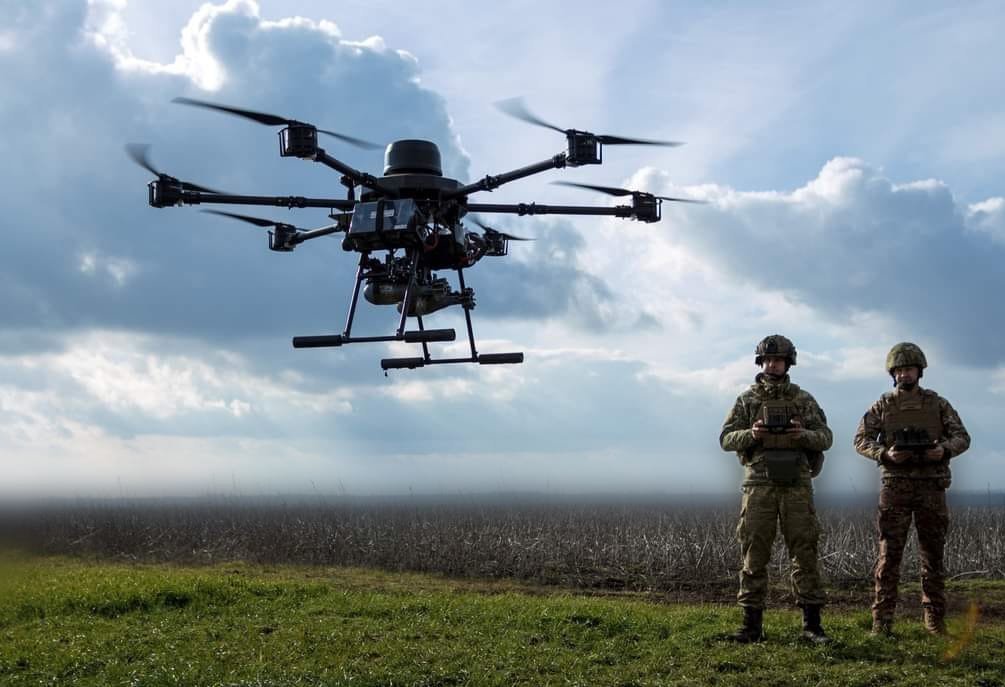Never before have armed drones played such a major role as in the war in Ukraine. Innovations on both sides are often adopted by the opponent. A new nightmare is now looming from the West.
With the Russian attack on Ukraine, the country has become the theatre of an unprecedented drone war. Unmanned aerial vehicles of various sizes and capabilities are being deployed. Initially, Ukraine still had the advantage: Even before the war broke out, the government in Kiev had procured large Bayraktar TB2 long-range drones from Turkey. Their attacks are said to have initially inflicted heavy losses on Russia’s military; one of the best-known missions was the battle for the so-called Snake Island off Odessa. The TB2 no longer plays an important role. With a wingspan of 12 metres, it is too sluggish and thus an easy target for Russian air defence.
As the war progressed, the Ukrainian army relied on small drones both for reconnaissance and for precision attacks. Vertical take-off multicopters can, for example, drop artillery shells over trenches or dive into enemy targets equipped with explosive devices. Ukraine now also uses Baba Yaga multicopters, which are around two metres wide and named after a well-known figure from Slavic mythology, to lay heavy anti-tank mines. In January, the military also surprised the public with aerial footage showing a Russian soldier who had surrendered being guided behind Ukrainian lines by a quadrocopter.
Many of the small unmanned aerial vehicles are produced inexpensively in Ukraine. The government in Kiev has amended laws specifically for this purpose, according to which the state is giving up its monopoly on the production of unmanned weapons. The focus is on so-called first-person view (FPV) drones, which are controlled using goggles. Ukraine claims to have already trained 20,000 drone operators for this purpose.
However, most of the small drones come from commercial manufacturers abroad, including the Chinese market leader DJI. The website “Defense News” wrote in autumn that the Ukrainian Prime Minister had spoken at an event about his military buying up “effectively 60 percent” of the global production of DJI drones. The company has vigorously refuted this claim. DJI officially ended its business in both countries in April 2022. Nevertheless, Chinese drones are still being sent to Russia and Ukraine en masse.
The innovations in the Ukraine war also include so-called kamikaze drones. Such fixed-wing aircraft have already been used by Azerbaijan in the war against Nagorno-Karabakh, but on a much smaller scale. The aircraft, which are equipped with a warhead, can be programmed for a target and destroy themselves when deployed. Whether this type of weapon can therefore be described as drones or if it is more a smart artillery munition is disputed among military experts. In the Ukraine war, the devices are primarily being used by Russia to attack Ukraine’s civilian infrastructure; the Lancet and the Shahed are Iranian-made.
Ukraine now wants to catch up in this segment and plans to produce thousands of long-range kamikaze drones this year that can also reach Moscow and St. Petersburg. To this end, private start-ups in particular are receiving financial support. The technology is intended to compensate for the lack of artillery shells on the front line, said Mykhailo Fedorov, Deputy Prime Minister and Minister for Digital Transformation of Ukraine.
Last week, Ukraine once again took the drone war to a new level. President Zelenskyi has created a new category of troops called “Unmanned Systems”. This is not just about flying drones, as the systems have also proven to be effective in ground and naval combat, according to Zelenskyi. The use of sea drones – unmanned boats with a large explosive load that can travel above or under water – has pushed the Russian Black Sea Fleet away from both the southern Ukrainian coast and the area around the Crimean peninsula.
Western supporters, including Germany, are also supplying Ukraine with unmanned aerial vehicles of various sizes. Latvia is leading a “drone coalition” that wants to provide $250 million for this purpose. The aim is to deliver one million drones to the country. This will include thousands of kamikaze drones that can operate in swarms with the help of artificial intelligence. They can identify enemy positions themselves without the need for human operators to intervene.
This type of attack technology has not been tried and tested in any armed conflict yet. Such armed swarms of drones are the nightmare of peace groups, who have been warning for years about the increasing autonomy of unmanned killer weapons.
Published in German in „nd“.
Image: Giant multicopters can transport up to 15 kilograms of ammunition and even lay anti-tank mines.





Leave a Reply